Related Research Articles

The New General Catalogue of Nebulae and Clusters of Stars is an astronomical catalogue of deep-sky objects compiled by John Louis Emil Dreyer in 1888. The NGC contains 7,840 objects, including galaxies, star clusters and emission nebulae. Dreyer published two supplements to the NGC in 1895 and 1908, known as the Index Catalogues, describing a further 5,386 astronomical objects. Thousands of these objects are best known by their NGC or IC numbers, which remain in widespread use.

The Orion Nebula is a diffuse nebula situated in the Milky Way, being south of Orion's Belt in the constellation of Orion, and is known as the middle "star" in the "sword" of Orion. It is one of the brightest nebulae and is visible to the naked eye in the night sky with apparent magnitude 4.0. It is 1,344 ± 20 light-years (412.1 ± 6.1 pc) away and is the closest region of massive star formation to Earth. The M42 nebula is estimated to be 24 light-years across. It has a mass of about 2,000 times that of the Sun. Older texts frequently refer to the Orion Nebula as the Great Nebula in Orion or the Great Orion Nebula.
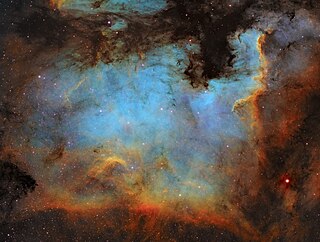
The North America Nebula is an emission nebula in the constellation Cygnus, close to Deneb. It is named because its shape resembles North America.
The year 1654 in science and technology involved some significant events.

The Lagoon Nebula is a giant interstellar cloud in the constellation Sagittarius. It is classified as an emission nebula and has an H II region.
Messier 102 is a galaxy listed in the Messier Catalogue that cannot be unambiguously identified. Its original discoverer Pierre Méchain retracted his discovery two years after publication and said that it was a duplicate observation of Messier 101. Later historical evidence favors that M102 is actually the galaxy NGC 5866, although other galaxies have been suggested as possible identities. The National Aeronautics and Space Administration (NASA) considers it to be the same as NGC 5866.
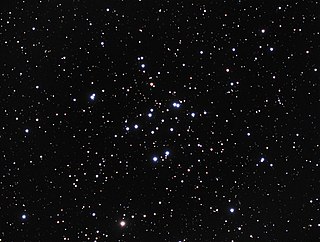
Messier 34 is a large and relatively near open cluster in Perseus. It was probably discovered by Giovanni Batista Hodierna before 1654 and included by Charles Messier in his catalog of comet-like objects in 1764. Messier described it as, "A cluster of small stars a little below the parallel of γ (Andromedae). In an ordinary telescope of 3 feet one can distinguish the stars."
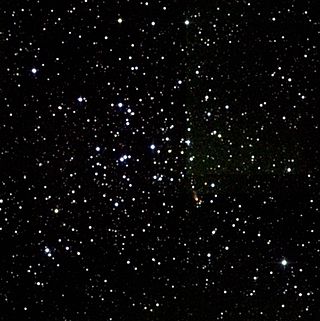
Messier 36 or M36, also known as NGC 1960 or the Pinwheel Cluster, is an open cluster of stars in the somewhat northern Auriga constellation. It was discovered by Giovanni Batista Hodierna before 1654, who described it as a nebulous patch. The cluster was independently re-discovered by Guillaume Le Gentil in 1749, then Charles Messier observed it in 1764 and added it to his catalogue. It is about 1,330 pc away from Earth. The cluster is very similar to the Pleiades cluster (M45), and if as far away it would be of similar apparent magnitude.

Messier 38 or M38, also known as NGC 1912 or Starfish Cluster, is an open cluster of stars in the constellation of Auriga. It was discovered by Giovanni Batista Hodierna before 1654 and independently found by Le Gentil in 1749. The open clusters M36 and M37, also discovered by Hodierna, are often grouped together with M38. Distance is about 1.066 kpc (3,480 ly) away from Earth. The open cluster NGC 1907 lies nearby on the sky, but the two are most likely just experiencing a fly-by, having originated in different parts of the galaxy.

Messier 58 is an intermediate barred spiral galaxy with a weak inner ring structure located within the constellation Virgo, approximately 68 million light-years away from Earth. It was discovered by Charles Messier on April 15, 1779 and is one of four barred spiral galaxies that appear in Messier's catalogue. M58 is one of the brightest galaxies in the Virgo Cluster. From 1779 it was arguably the farthest known astronomical object until the release of the New General Catalogue in the 1880s and even more so the publishing of redshift values in the 1920s.
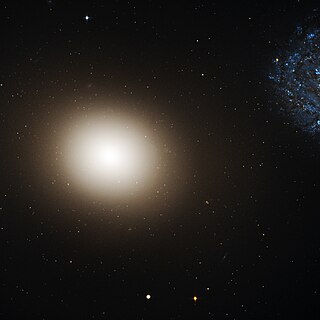
Messier 60 or M60, also known as NGC 4649, is an elliptical galaxy approximately 57 million light-years away in the equatorial constellation of Virgo. Together with NGC 4647, it forms a pair known as Arp 116. Messier 60 and nearby elliptical galaxy Messier 59 were discovered by Johann Gottfried Koehler in April 1779, observing a comet in the same part of the sky. Charles Messier added both to his catalogue about three days after this.
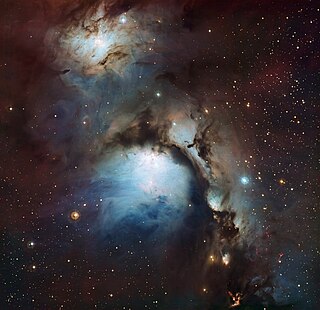
Messier 78 or M78, also known as NGC 2068, is a reflection nebula in the constellation Orion. It was discovered by Pierre Méchain in 1780 and included by Charles Messier in his catalog of comet-like objects that same year.

Messier 92 is a globular cluster of stars in the northern constellation of Hercules.

Messier 93 or M93, also known as NGC 2447 or the Critter Cluster, is an open cluster in the modestly southern constellation Puppis, the imagined poop deck of the legendary Argo.
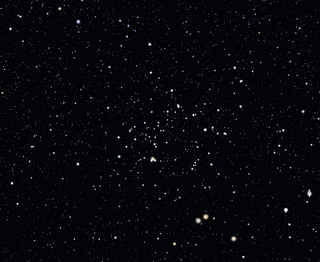
NGC 752 is an open cluster in the constellation Andromeda. The cluster was discovered by Caroline Herschel in 1783 and cataloged by her brother William Herschel in 1786, although an object that may have been NGC 752 was described by Giovanni Batista Hodierna before 1654.

Giovanni Battista Hodierna, also spelled as Odierna was an Italian astronomer at the court of Giulio Tomasi, Duke of Palma. He compiled a catalogue of comets and other celestial objects containing some 40 entries, including at least 19 real and verifiable nebulous objects that might be confused with comets.
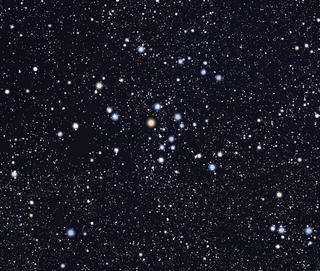
NGC 2451 is an open cluster in the Puppis constellation, probably discovered by Giovanni Battista Hodierna before 1654 and John Herschel in 1835. In 1994, it was postulated that this was actually two open clusters that lie along the same line of sight. This was confirmed in 1996. The respective clusters are labeled NGC 2451 A and NGC 2451 B, and they are located at distances of 600 and 1,200 light-years, respectively.

NGC 6231 is an open cluster in the southern sky located half a degrees north of Zeta Scorpii. NGC 6231 is part of a swath of young, bluish stars in the constellation Scorpius known as the Scorpius OB1 association. The star Zeta1 is a member of this association, while its brighter apparent partner, Zeta2, is only 150 ly from Earth and so is not a member.
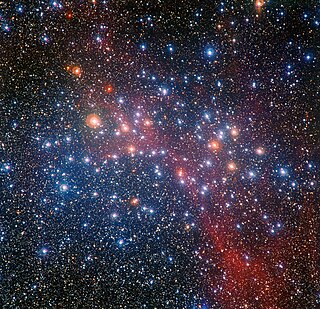
NGC 3532, also commonly known as the Pincushion Cluster, Football Cluster, the Black Arrow Cluster, or the Wishing Well Cluster, is an open cluster some 405 parsecs from Earth in the constellation Carina. Its population of approximately 150 stars of 7th magnitude or fainter includes seven red giants and seven white dwarfs. On 20 May 1990 it became the first target ever observed by the Hubble Space Telescope. A line from Beta Crucis through Delta Crucis passes somewhat to the north of NGC 3532. The cluster lies between the constellation Crux and the larger but fainter "False Cross" asterism. The 4th-magnitude Cepheid variable star x Carinae appears near the southeast fringes, but it lies between the Sun and the cluster and is not a member of the cluster.
NGC 5662 is an open cluster in the constellation Centaurus. It was discovered by Nicolas Louis de Lacaille on May 17, 1752 from South Africa. James Dunlop observed it on July 10, 1826 from Parramatta, Australia and added it to his catalog as No. 342.
References
- 1 2 3 4 5 6 7 8 Frommert, H.; Kronberg, C. (14 May 2012). "Giovanni Battista Hodierna (April 13, 1597 – April 6, 1660)". SEDS . Retrieved 2015-07-31.
- 1 2 3 4 5 Fodera-Serio, G.; Indorato, L.; Nastasi, P. (1985). "G.B. Hodierna's Observations of Nebulae and his Cosmology". Journal for the History of Astronomy . 16: 1–36. Bibcode:1985JHA....16....1F. doi:10.1177/002182868501600101. S2CID 118328541.
- ↑ Frommert, H.; Kronberg, C. (25 August 2007). "Hodierna's Deep Sky Observations". SEDS . Retrieved 2015-08-11.